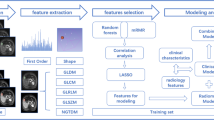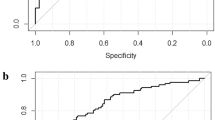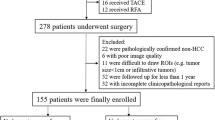Abstract
Purpose
This study was conducted in order to investigate the value of magnetic resonance imaging (MRI)-based radiomics signatures for the preoperative prediction of hepatocellular carcinoma (HCC) grade.
Methods
Data from 170 patients confirmed to have HCC by surgical pathology were divided into a training group (n = 125) and a test group (n = 45). The radiomics features of tumours based on both T1-weighted imaging (WI) and T2WI were extracted by using Matrix Laboratory (MATLAB), and radiomics signatures were generated using the least absolute shrinkage and selection operator (LASSO) logistic regression model. The predicted values of pathological HCC grades using radiomics signatures, clinical factors (including age, sex, tumour size, alpha fetoprotein (AFP) level, history of hepatitis B, hepatocirrhosis, portal vein tumour thrombosis, portal hypertension and pseudocapsule) and the combined models were assessed.
Results
Radiomics signatures could successfully categorise high-grade and low-grade HCC cases (p < 0.05) in both the training and test datasets. Regarding the performances of clinical factors, radiomics signatures and the combined clinical and radiomics signature (from the combined T1WI and T2WI images) models for HCC grading prediction, the areas under the curve (AUCs) were 0.600, 0.742 and 0.800 in the test datasets, respectively. Both the AFP level and radiomics signature were independent predictors of HCC grade (p < 0.05).
Conclusions
Radiomics signatures may be important for discriminating high-grade and low-grade HCC cases. The combination of the radiomics signatures with clinical factors may be helpful for the preoperative prediction of HCC grade.
Key Points
• The radiomics signature based on non-contrast-enhanced MR images was significantly associated with the pathological grade of HCC.
• The radiomics signatures based on T1WI or T2WI images performed similarly at predicting the pathological grade of HCC.
• Combining the radiomics signature and clinical factors (including age, sex, tumour size, AFP level, history of hepatitis B, hepatocirrhosis, portal vein tumour thrombosis, portal hypertension and pseudocapsule) may be helpful for the preoperative prediction of HCC grade.






Similar content being viewed by others
Abbreviations
- 3D:
-
Three-dimensional
- AFP:
-
Alpha fetoprotein
- AUC:
-
Area under the curve
- CHB:
-
Chronic hepatitis B
- CI:
-
Confidence interval
- DWI:
-
Diffusion-weighted imaging
- GLCM:
-
Grey-level co-occurrence matrix
- GLN:
-
Grey-level run-length non-uniformity
- GLRLM:
-
Grey-level run-length matrix
- HCC:
-
Hepatocellular carcinoma
- LASSO:
-
Least absolute shrinkage and selection operator
- MRI:
-
Magnetic resonance imaging
- MVI:
-
Microvascular invasion
- NSCLC:
-
Non-small cell lung cancer
- OR:
-
Odds ratio
- PACS:
-
Picture archiving and communication system
- ROC:
-
Receiver operating characteristic
- ROI:
-
Region of interest
- T1WI:
-
T1-weighted imaging
- T2WI:
-
T2-weighted imaging
- TE:
-
Echo time
- TR:
-
Repetition time
References
Njei B, Rotman Y, Ditah I, Lim JK (2015) Emerging trends in hepatocellular carcinoma incidence and mortality. Hepatology 61:191–199
El-Serag HB (2012) Epidemiology of viral hepatitis and hepatocellular carcinoma. Gastroenterology 142:1264–1273
Torre LA, Bray F, Siegel RL, Ferlay J, Lortet-Tieulent J, Jemal A (2015) Global cancer statistics, 2012. CA Cancer J Clin 65:87–108
Sasaki A, Kai S, Iwashita Y, Hirano S, Ohta M, Kitano S (2005) Microsatellite distribution and indication for locoregional therapy in small hepatocellular carcinoma. Cancer 103:299–306
Ng IO, Lai EC, Fan ST, Ng MM, So MK (1995) Prognostic signifcance of pathologic features of hepatocellular carcinoma: a multivariate analysis of 278 patients. Cancer 76:2443–2448
Okusaka T, Okada S, Ueno H et al (2002) Satellite lesions in patients with small hepatocellular carcinoma with reference to clinicopathologic features. Cancer 95:1931–1937
Bruix J, Sherman M (2005) Management of hepatocellular carcinoma. Hepatology 42:1208–1236
Parmar C, Leijenaar RT, Grossmann P et al (2015) Radiomic feature clusters and prognostic signatures specific for lung and head & neck cancer. Sci Rep 5:11044
Lambin P, Rios-Velazquez E, Leijenaar R et al (2012) Radiomics: extracting more information from medical images using advanced feature analysis. Eur J Cancer 48:441–446
Kumar V, Gu Y, Basu S et al (2012) Radiomics: the process and the challenges. Magn Reson Imaging 30:1234–1248
Goh V, Ganeshan B, Nathan P, Juttla JK, Vinayan A, Miles KA (2011) Assessment of response to tyrosine kinase inhibitors in metastatic renal cell cancer: CT texture as a predictive biomarker. Radiology 261:165–171
Ganeshan B, Goh V, Mandeville HC, Ng QS, Hoskin PJ, Miles KA (2013) Non-small cell lung cancer: histopathologic correlates for texture parameters at CT. Radiology 266:326–336
Ng F, Ganeshan B, Kozarski R, Miles KA, Goh V (2013) Assessment of primary colorectal cancer heterogeneity by using whole-tumor texture analysis: contrast-enhanced CT texture as a biomarker of 5-year survival. Radiology 266:177–184
Zhang H, Graham CM, Elci O et al (2013) Locally advanced squamous cell carcinoma of the head and neck: CT texture and histogram analysis allow independent prediction of overall survival in patients treated with induction chemotherapy. Radiology 269:801–809
Yip C, Landau D, Kozarski R, Ganeshan B, Thomas R, Michaelidou A et al (2014) Primary esophageal cancer: heterogeneity as potential prognostic biomarker in patients treated with defnitive chemotherapy and radiation therapy. Radiology 270:141–148
Liu S, Liu S, Ji C et al (2017) Application of CT texture analysis in predicting histopathological characteristics of gastric cancers. Eur Radiol 27:4951–4959
Ganeshan B, Abaleke S, Young RC, Chatwin CR, Miles KA (2010) Texture analysis of non-small cell lung cancer on unenhanced computed tomography: initial evidence for a relationship with tumour glucose metabolism and stage. Cancer Imaging 10:137–143
Ganeshan B, Skogen K, Pressney I, Coutroubis D, Miles K (2012) Tumour heterogeneity in oesophageal cancer assessed by CT texture analysis: preliminary evidence of an association with tumour metabolism, stage, and survival. Clin Radiol 67:157–164
Liang CS, Huang YQ, He L et al (2016) The development and validation of a CT-based radiomics signature for the preoperative discrimination of stage I-II and stage III-IV colorectal cancer. Oncotarget 7:31401–31412
Ayuso C, Rimola J, Garcia-Criado A (2012) Imaging of HCC. Abdom Imaging 37:215–230
Nasu K, Kuroki Y, Tsukamoto T, Nakajima H, Mori K, Minami M (2009) Diffusion-weighted imaging of surgically resected hepatocellular carcinoma: imaging characteristics and relationship among signal intensity, apparent diffusion coefficient, and histopathologic grade. AJR Am J Roentgenol 193:438–444
Nishie A, Tajima T, Asayama Y et al (2011) Diagnostic performance of apparent diffusion coefficient for predicting histological grade of hepatocellular carcinoma. Eur J Radiol 80:e29–e33
Kogita S, Imai Y, Okada M et al (2010) Gd-EOB-DTPA-enhanced magnetic resonance images of hepatocellular carcinoma: correlation with histological grading and portal blood flow. Eur Radiol 20:2405–2413
Zhou W, Zhang LJ, Wang KX et al (2017) Malignancy characterization of hepatocellular carcinomas based on texture analysis of contrast-enhanced MR images. J Magn Reson Imaging 45:1476–1484
Edmondson HA, Steiner PE (1954) Primary carcinoma of the liver. A study of 100 cases among 48,900 necropsies. Cancer 7:462–503
Coroller TP, Grossmann P, Hou Y et al (2015) CT-based radiomic signature predicts distant metastasis in lung adenocarcinoma. Radiother Oncol 114:345–350
Leijenaar RT, Carvalho S, Hoebers FJ et al (2015) External validation of a prognostic CT-based radiomic signature in oropharyngeal squamous cell carcinoma. Acta Oncol 54:1423–1429
Zhou L, Rui JA, Zhou WX, Wang SB, Chen SG, Qu Q (2017) Edmondson-Steiner grade: a crucial predictor of recurrence and survival in hepatocellular carcinoma without microvascular invasion. Pathol Res Pract 213:824–830
Chung JW, Jang ES, Kim J et al (2017) Development of a nomogram for screening of hepatitis B virusassociated hepatocellular carcinoma. Oncotarget 8:106499–106510
Bai DS, Zhang C, Chen P, Jin SJ, Jiang GQ (2017) The prognostic correlation of AFP level at diagnosis with pathological grade, progression, and survival of patients with hepatocellular carcinoma. Sci Rep 7:12870
Funding
The authors state that this work has not received any funding.
Author information
Authors and Affiliations
Corresponding author
Ethics declarations
Guarantor
The scientific guarantor of this publication is Dapeng Shi.
Conflict of interest
The authors of this manuscript declare no relationships with any companies, whose products or services may be related to the subject matter of the article.
Statistics and biometry
No complex statistical methods were necessary for this paper.
Informed consent
Written informed consent was obtained from all subjects (patients) in this study.
Ethical approval
Institutional Review Board approval was obtained.
Methodology
• Retrospective
• Diagnostic or prognostic study
• Performed at one institution
Electronic supplementary material
ESM 1
(DOC 567 kb)
Rights and permissions
About this article
Cite this article
Wu, M., Tan, H., Gao, F. et al. Predicting the grade of hepatocellular carcinoma based on non-contrast-enhanced MRI radiomics signature. Eur Radiol 29, 2802–2811 (2019). https://doi.org/10.1007/s00330-018-5787-2
Received:
Revised:
Accepted:
Published:
Issue Date:
DOI: https://doi.org/10.1007/s00330-018-5787-2




